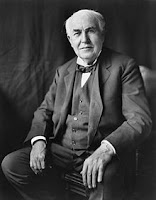IET, July 1, 2020; Crystal Quintero, CC Liu, Ashley Wells (eds.), Wisdom Quarterly Wiki edit
 |
| Celebrating Black History Month (all year long) |
Lewis Howard Latimer Life Story: Inventor and Innovator
 |
| Lewis Howard Latimer |
Lewis Howard Latimer, the man who played an important role in Edison and Bell’s historic work and whose inventions have touched our lives in more ways than we know, is an unsung Black hero.
This is his life story: Black inventor and innovator Latimer was born on Sept. 4, 1848, in Chelsea, Massachusetts, USA, as the youngest of four children born to George and Rebecca Latimer.
Six years prior to Latimer’s birth, his parents had been chattel slaves in the state of Virginia. They managed to escape and sought freedom in Boston, Massachusetts, but shortly after arriving in Boston, father George Latimer was recognized as a fugitive and jailed.
There was a trial, and the attempts to recapture George and return him to Virginia caused considerable agitation in Boston. When the trial judge ruled that Latimer still belonged to his Virginia owner, an African-American minister paid $400 for his release.
 |
| Edison: He was a great help to me. |
With this very humble background, Lewis Latimer’s family could only afford a few years of grammar school for him and his siblings. He developed a keen interest in the arts but especially in drawing, a skill that would benefit him hugely throughout his life.
By the time of his adolescence, the Civil War had engulfed America, and in 1864, at the age of 16, he enlisted in the Union Navy.
At the close of the war, Latimer was honorably discharged and secured employment as an office boy with the patent law firm called Crosby and Gould.
Keen to advance himself and utilizing his interest in drawing, Latimer taught himself mechanical drawing. His perseverance and passion paid off, and he eventually managed to become chief draftsman at the firm during his 11 years.
He met and married Mary Wilson, with whom he would go on to father two daughters.
Latimer and Bell
Lewis Latimer secured his first patent in 1874 for the Water Closet, an improved toilet system for railroad cars and, in 1876, he was hired by Alexander Graham Bell.
 |
| Bell: We're making history, boys. |
Latimer’s expertise in drafting meant that on Feb. 14 (Valentine's Day?), 1876, Bell’s telephone patent was filed just a few hours earlier than Bell’s rival inventor, Elisha Gray.
If it had not been for Latimer’s expertise and knowledge, Bell would not have the fame for telephony he still holds in the world today.
Light bulb invention
In 1880, Latimer began to work as a mechanical draftsman for Hiram Maxim, founder of the U.S. Electric Lighting Company and a fierce competitor to Thomas Edison.
Here, Latimer learned so much about lightbulbs that by 1881, along with Joseph Nichols, he registered a patent for a light bulb with a carbon filament.
Shortly afterwards, he received another patent for "the process of manufacturing carbons," which was an improvement on the method for the production of carbon filaments used inside light bulbs.
Latimer and Edison
 |
| Electric Lighting, 1890 (Latimer) |
Impressed by Latimer’s technical knowledge, Edison encouraged Latimer to write his first book Incandescent Electric Lighting: A Practical Description of the Edison System.
Latimer would also go on to become one of the charter members of the Edison’s Pioneers, where he was the only African-American member of the highly prestigious group.
Air conditioning
 |
| What is the secret to making ice? - High five? |
Latimer stayed with Edison’s company throughout the years as it merged with other companies to form General Electric, the same American company that is active today.
Lewis Howard Latimer came from so little and at a time in history where he was a second-class Black citizen in a very racist, white supremacist society that his accomplishments are astonishing.
But through hard work and determination, he managed to rise up and make important advancements in many practical scientific technologies that we use today.
Although "Latimer" is not a household name like his contemporaries and colleagues, he truly deserves a place alongside them.
Lewis Latimer inventions:
- Light Bulb Invention
- Air Conditioning Inventor
- Helped Alexander Graham Bell who invented the telephone (patent provider)
- Water Closet for Railroad Cars
- Locking rack for hats, coats, and umbrellas
If he's so famous, why doesn't he have a Wikipedia entry?
He does! Lewis Howard Latimer (Sept. 4, 1848–Dec. 11, 1928) was a scientist, American inventor, and patent draftsman.
 |
| The Dems let us down worse than racist Trump |
His inventions included an evaporative air conditioner, an improved process for manufacturing carbon filaments for light bulbs, and an improved toilet system for railroad cars.
In 1884, he joined the Edison Electric Light Company where he worked as a draftsman. Latimer's innovations in the design of carbon filaments, which were used in incandescent light bulbs, significantly improved the bulb's efficiency and made it more practical for everyday use. [Wait, that wasn't Edison himself making these improvements?]
Latimer's contributions to the lighting industry helped make electric lighting more accessible and affordable for all Americans [1].
While Thomas Edison is often credited with inventing the practical incandescent light bulb, it was actually Latimer's contribution to its development that were invaluable. Latimer played a crucial role in advancing the technology.
The Lewis H. Latimer House, his landmarked former residence, is located near the Latimer Projects at 34-41 137th Street in Flushing, Queens, New York City. More

.jpg)





















































































































































































































































No comments:
Post a Comment